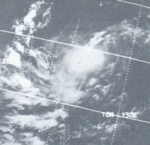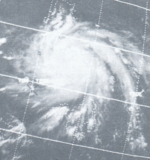1971 Pacific typhoon season
| 1971 Pacific typhoon season |

Season summary map
|
| Seasonal boundaries |
| First system formed |
January 8, 1971 |
| Last system dissipated |
December 30, 1971 |
| Strongest storm |
|
| Name |
Irma |
| • Maximum winds |
285 km/h (180 mph)
(1-minute sustained) |
| • Lowest pressure |
885 hPa (mbar) |
| Seasonal statistics |
| Total depressions |
55 |
| Total storms |
35 |
| Typhoons |
24 |
| Super typhoons |
6 |
| Total fatalities |
At least 617 total |
| Total damage |
$57.7 million (1971 USD) |
| Related articles |
|
|
Pacific typhoon seasons
1969, 1970, 1971, 1972, 1973
|
| Severe tropical storm (JMA) |
| Tropical Storm (SSHWS) |
|
|
| Duration |
January 8 – January 11 |
| Peak intensity |
95 km/h (60 mph) (1-min) 990 hPa (mbar) |
| Tropical Storm (JMA) |
| Tropical Storm (SSHWS) |
|
|
| Duration |
March 16 – March 21 |
| Peak intensity |
85 km/h (50 mph) (1-min) 994 hPa (mbar) |
| Typhoon (JMA) |
| Category 2 typhoon (SSHWS) |
|
|
| Duration |
April 6 – April 19 |
| Peak intensity |
165 km/h (105 mph) (1-min) 965 hPa (mbar) |
| Typhoon (JMA) |
| Category 1 typhoon (SSHWS) |
|
|
| Duration |
April 22 – May 5 |
| Peak intensity |
140 km/h (85 mph) (1-min) 980 hPa (mbar) |
| Typhoon (JMA) |
| Category 5 super typhoon (SSHWS) |
|
|
| Duration |
April 27 – May 7 |
| Peak intensity |
280 km/h (175 mph) (1-min) 890 hPa (mbar) |
| Severe tropical storm (JMA) |
| Tropical Storm (SSHWS) |
|
|
| Duration |
May 2 – May 7 |
| Peak intensity |
100 km/h (65 mph) (1-min) 990 hPa (mbar) |
| Severe tropical storm (JMA) |
| Tropical Storm (SSHWS) |
|
|
| Duration |
May 17 – May 23 |
| Peak intensity |
95 km/h (60 mph) (1-min) 995 hPa (mbar) |
| Typhoon (JMA) |
| Category 2 typhoon (SSHWS) |
|
|
| Duration |
May 23 – May 31 |
| Peak intensity |
165 km/h (105 mph) (1-min) 960 hPa (mbar) |
| Tropical Storm (JMA) |
| Tropical Storm (SSHWS) |
|
|
| Duration |
May 27 – June 3 |
| Peak intensity |
65 km/h (40 mph) (1-min) 1000 hPa (mbar) |
The 1971 Pacific typhoon season has no official bounds; it ran year-round in 1971, but most tropical cyclones tend to form in the northwestern Pacific Ocean between June and December. These dates conventionally delimit the period of each year when most tropical cyclones form in the northwestern Pacific Ocean.
The scope of this article is limited to the Pacific Ocean, north of the equator and west of the international date line. Storms that form east of the date line and north of the equator are called hurricanes; see 1971 Pacific hurricane season. Tropical Storms formed in the entire west pacific basin were assigned a name by the Joint Typhoon Warning Center. Tropical depressions in this basin have the "W" suffix added to their number. Tropical depressions that enter or form in the Philippine area of responsibility are assigned a name by the Philippine Atmospheric, Geophysical and Astronomical Services Administration or PAGASA. This can often result in the same storm having two names.
According to the United States Joint Typhoon Warning Center, the 1971 season was the most active season since 1967, with a total of 35 tropical storms being monitored by them during the year. In addition to the 35 tropical storms, the Japan Meteorological Agency considered Tropical Depression 25W to be a tropical storm additional tropical storm, which was only classified as a tropical depression by the JTWC.
During January 8, the JMA started to monitor a tropical depression that had developed, about 500 km (310 mi) to the east of Ngerulmud, Palau. Over the next day the system gradually developed further as it moved north-westwards, before it was classified as a tropical storm and named Sarah by the JTWC, after a US Navy plane had found an organised system. The system subsequently recurved north-eastwards, before it was classified as a Severe Tropical Storm by the JMA during January 10. During that day, the JTWC reported that the system had peaked, with 1-minute sustained wind-speeds of 95 km/h (60 mph). Over the next day, the system quickly weakened and became an extratropical cyclone during January 11. Sarah's extratropical remnants were subsequently tracked as they moved north-eastwards, until it made landfall on Canada and broke up over the mountains of British Columbia during January 17.
...
Wikipedia


















